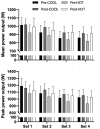Short-Term Repeated-Sprint Training in Hot and Cool Conditions Similarly Benefits Performance in Team-Sport Athletes
- PMID: 33013443
- PMCID: PMC7493664
- DOI: 10.3389/fphys.2020.01023
Short-Term Repeated-Sprint Training in Hot and Cool Conditions Similarly Benefits Performance in Team-Sport Athletes
Abstract
This study compared the performance and physiological adaptations of short-term repeated-sprint training in HOT [40°C and 40% relative humidity (RH)] and COOL (20°C and 40% RH) conditions in team-sport athletes. Twenty-five trained males completed five training sessions of 60 min over 7 days in HOT (n = 13) or COOL (n = 12) conditions, consisting of a submaximal warm-up and four sets of maximal sprints. Before and after the intervention, intermittent shuttle running performance was assessed in cool and repeated-sprint ability in hot conditions; the latter preceded and followed by neuromuscular function testing. During the repeated-sprint training sessions, skin (~8.4°C) and core (~0.17°C) temperatures were higher in HOT than COOL (p < 0.05) conditions. Shuttle running distance increased after both interventions (p < 0.001), with a non-significant (p = 0.131) but larger effect in HOT (315 m, d = 1.18) than COOL (207 m, d = 0.51) conditions. Mean (~7%, p < 0.001) and peak (~5%, p < 0.05) power during repeated-sprinting increased following both interventions, whereas peak twitch force before the repeated-sprint assessment was ~10% lower after the interventions (p = 0.001). Heart rate during the repeated-sprint warm-up was reduced (~6 beats.min-1) following both interventions (p < 0.01). Rectal temperature was ~0.14°C lower throughout the repeated-sprint assessment after the interventions (p < 0.001), with larger effects in HOT than COOL during the warm-up (p = 0.082; d = -0.53 vs. d = -0.15) and repeated-sprints (p = 0.081; d = -0.54 vs. d = -0.02). Skin temperature (p = 0.004, d = -1.11) and thermal sensation (p = 0.015, d = -0.93) were lower during the repeated-sprints after training in HOT than COOL. Sweat rate increased (0.2 L.h-1) only after training in HOT (p = 0.027; d = 0.72). The intensive nature of brief repeated-sprint training induces similar improvements in repeated-sprint cycling ability in hot conditions and intermittent running performance in cool conditions, along with analogous physiological adaptations, irrespective of the environmental conditions in which training is undertaken.
Keywords: heat acclimation; intermittent sports; repeated-sprint ability; running; thermoregulation.
Copyright © 2020 Périard, Pyne, Bishop, Wallett and Girard.
Figures





References
-
- Armstrong L. E., Pandolf K. B. (1988). “Physical training, cardiorespiratory physical fitness and exercise-heat tolerance” in Human performance physiology and environmental medicine at terrestrial extremes. eds. Pandolf K. B., Sawka M. N., Gonzalez R. R. (Indianapolis, IN: Benchmark Press; ), 199–226.
-
- American Society of Heating, Refrigeration and Air-Conditioning (1966). Thermal comfort conditions. ASHRAE standard 55:66. New York.
LinkOut - more resources
Full Text Sources
Miscellaneous

